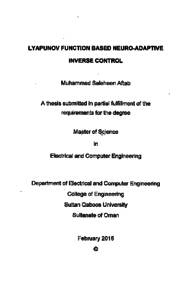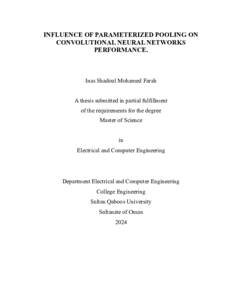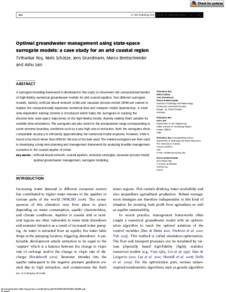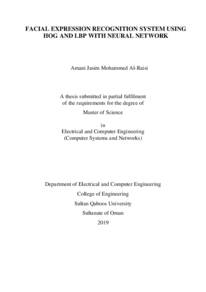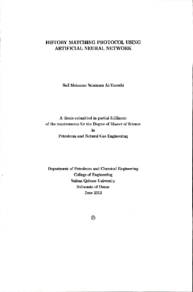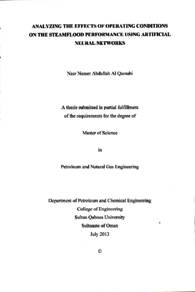Document
Lyapunov function based neuro-adaptive inverse control
Publisher
Sultan Qaboos University
Gregorian
2015
Language
English
Subject
English abstract
The development of conventional controllers fundamentally depends upon availability of the exact mathematical model of the dynamic system. However, most of the real-world systems are harnessed with unknown nonlinearities and dynamic uncertainties. Therefore, controllers designed with imprecise knowledge result in poor performance. This reason has motivated the development of adaptive controllers that handle dynamic uncertainties with adaptive adjustment of controller parameters on run-time.
On the other hand, soft computing techniques such as artificial neural networks closely resemble to adaptive systems in terms of architecture and learning capabilities. In fact, artificial neural networks have been extensively used as adaptive inverse controllers. However, the majority of available neuro-adaptive inverse controllers are associated with two significant problems. First, the neural networks are trained with the conventional gradient descent backpropagation learning algorithms that suffer from slow convergence and frequently trap at the local minima of the error cost function Second, these adaptive control techniques do not establish mathematical foundations for error convergence and closed-loop stability conditions. Instead, they assume the convergence and stability based on the Certainty Equivalence Principle, which is not a realistic assumption. These problems make the performance of the adaptive controller unreliable.
A neuro-adaptive inverse control technique for single-input single-output dynamic plants that overcomes the aforementioned problems is proposed and discussed in this research work. A Lyapunoy function based backpropagation learning algorithm for neural network training has been presented. The proposed backpropagation algorithm guarantees fast convergence and assures single global minimum with adaptive adjustment of the network parameters. Moreover, an adaptive inverse control architecture has been presented that uses two Lyapunov function neural networks in a unified framework. In this scheme, one neural network acts as the inverse dynamics controller whereas the other functions as an estimator to calculate the control command. The error convergence and closed-loop stability of the inverse controller have been proved with the Lyapunov Stability Theory. Furthermore, the controller performance has been studied with four simulation examples and two laboratory-scale experimental setups. These case studies show that tracking of the continuous trajectories is achieved and local minima trapping is not observed. The simulation and experimental results validate theoretical findings.
Member of
Resource URL
Arabic abstract
يعتمد تطوير وحدات التحكم التقليدية بشكل أساسي على توافر النموذج الرياضي الدقيق للنظام الدينامیکی معظم أنظمة التحكم العملية يوجد بها مصادر لأخطية غير معروفة وشكوك ديناميكية . ولذلك، فإن وحدات التحكم التي تصمم لمثل هذه الأنظمة تتميز بضعف الأداء . وقد حفز هذا السبب لتطوير وحدات تحكم تكيفية تتعامل مع هذه الأنظمة باستخدام بارامترات التحكم والتي يتم ضبطها اثناء التشغيل . من ناحية أخرى، فإن تقنيات الحوسبة الناعمة مثل الشبكات العصبية الاصطناعية قد استخدمت على نطاق واسع في تطوير وحدات تحكم تكيفية .ومع ذلك، ترتبط غالبية نظم التحكم العكسية التكيفية العصبية المتاحة على اثنين من العيوب كبيرة أولا، يتم تدريب الشبكات العصبية باستخدام خوارزم الانزلاق التدريجي التقليدي الميني على التعلم باستخدام الانتشار الخلفي مما ينشأ عنه بطء التقارب. وكثيرا ما يقع في القيم الصغري المحلية. ثانيا، هذه التقنيات السيطرة على التكيف لا تضع الأسس الرياضية التقارب الخطا وشروط الاستقرار بدلا من ذلك، أنها تفترض التقارب والاستقرار على أساس مبدأ التكافؤ اليقيني، وهي ليست افتراض واقعي . هذه العيوب تجعل أداء وحدات التحكم المتكيف لا يمكن الاعتماد عليها. في هذه الرسالة يتم اقتراح تقنية التحكم العكسي العصبية التكيفية لمنظومات أحادية المداخل و المخارج للتغلب على العيوب المذكورة أعلاه. تم عرض خوارزمية التعلم ذات الانتشار الخلفي باستخدام دالة ليابونوف. خوارزمية الانتشار الخلفي المقترحة تضمن التقارب السريع وتضمن عدم الوقوع في الحدود الصغرى المحلية مع تعديل تكيفي لمعلمات الشبكة . وعلاوة على ذلك، تم عرض بنية التكيفية السيطرة العكسية باستخدام شبكتين عصبيتين من نوع دالة ليابونوف .وعلاوة على ذلك، تمت دراسة أداء وحدة تحكم مع أربعة أمثلة محاكاة واثنين من الأنظمة المخبرية .وتشير دراسة هذه الحالات تحقیق تتبع المسارات المستمرة وقد لوحظ عدم الوقوع في القيم الصغرى المحلية. كما أثبتت نتائج المحاكاة والنتائج التجريبية التحقق من صحة النتائج النظرية.
Category
Theses and Dissertations

